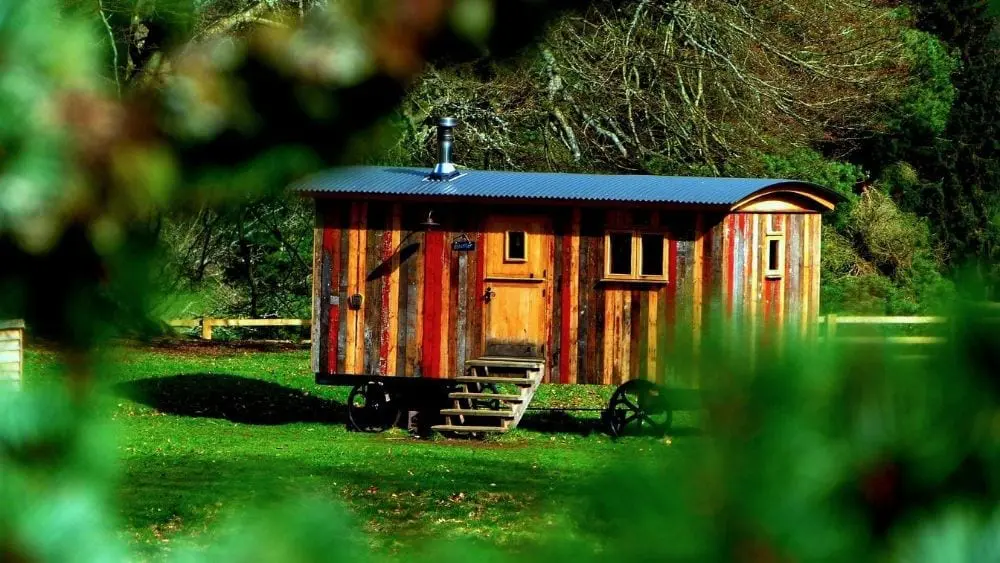
There are many planet-friendly benefits to living in a tiny home. It’s logical that a tiny home would take fewer resources to build and maintain, and thanks to new research, there is data to back up this assertion. Maria Saxton, a Ph.D. candidate in environmental planning and design at Virginia Polytechnic Institute, has focused her research on the effects of downsizing to a tiny home.
“I found that among 80 tiny home downsizers located across the U.S., ecological footprints were reduced by about 45 percent on average,” Saxton says. “Surprisingly, I found that downsizing can influence many parts of one’s lifestyle and reduce impacts on the environment in unexpected ways.”
Saxton found that, after downsizing, people were more likely to eat less energy-intensive food products and adopt more environmentally conscious eating habits, such as eating more locally and growing more of their own food. “Participants traveled less by car, motorcycle, bus, train and airplane, and drove more fuel-efficient cars than they did before downsizing,” she adds.
In this article, we explore some of the ways that living in a tiny home can benefit the environment (and, of course, your wallet).
Fewer Materials
It makes sense that a home under 400 square feet would need fewer materials to build than a 2,641 square foot home (which is the average size). Using fewer materials also impacts the transport of those materials, as fewer trucks are needed. And in the long run, fewer materials will be needed to make repairs or renovations, providing additional financial and environmental savings.
More Sustainable Materials
Sustainable materials, whether recycled or new to market, are a more realistic option for tiny homes for two reasons: 1) Recycled (or upcycled) materials are generally available in limited quantities, which may rule out their use in a larger home, and 2) the newest sustainable materials on the market — such as Tesla’s solar roof tiles, Hemcrete, and recycled cork flooring — may be cost prohibitive in large quantities, but affordable for a tiny house.
Reduced Energy Use
The average single-family home uses a lot of resources every day for electricity, heating and cooling, while a tiny house has considerably fewer needs due to its small size, fewer appliances and the fact that many tiny home dwellers spend a lot of time outdoors and away from home. Fossil fuel-based energy use results in carbon emissions — the largest contributor to climate change — totaling 28,000 pounds of carbon dioxide per year. By comparison, a 186-square-foot home results in only 2,000 pounds. That’s a massive difference, for your wallet and the planet!
Self-Sustaining is Possible
For the most eco-minded tiny home dwellers, it is possible to eliminate the dependency on fossil fuels completely by creating a self-sustaining home. Solar panels or tiles, reclaimed water, batteries, alcohol stoves and other solutions, whether by design or through modifications, make this a realistic possibility for tiny homes.
Fewer Things and Less Waste
Thanks to clever design, tiny homes do incorporate storage space, but still less than you would have with an average-size home. This means you have to be more careful with your purchases — buying better quality things, less impulse buying and less waste from packaging. “I love tiny houses for a number of environmental, economic and practical reasons,” explains Jay Shafer, considered by many to be the godfather of the tiny house movement. “But what first attracted me to them was how much more beautiful a well-utilized space is. Waste is ugly; efficiency is beautiful.” Tiny home living is generally conducive to a less wasteful lifestyle.
Going Green without Sacrifice
Sustainable living is too often associated with living without. “The misconception I think many people have and I admittedly had too is that somehow you’re going to have to make significant sacrifices or at least compromises in your design,” says Newt Hau, who resides in a 374-square-foot tiny home with his partner, Brooke. “With our tiny home, we can’t think of anything we’re compromising on. We have every convenience and comfort that we want and we still constantly exclaim how much room we have.”
It may sound trite and produce an eye-roll, but with tiny house living, less really is more. “Living small doesn’t mean you have to sacrifice,” agrees Ryan Grey Smith, founder of Modern–Shed, an architecture firm that designs small space solutions. “Quite the opposite, if you do it right. Living small could mean what’s left is the most important part of the experience.”
Are you looking to decrease your footprint by downsizing to a home with less square footage? Check out the latest offerings at NewHomeSource.

For the last 16 years, Rachel Kinbar has been a writer of articles, blog posts, white papers, essays, infographics, web copy, sales copy, scripts, poetry, lyrics, and more. She has keen research skills that she applies to a wide variety of topics, and she especially loves topics related to design, history, and sustainable living.
 How to Plan a Pet-Friendly Backyard
How to Plan a Pet-Friendly Backyard